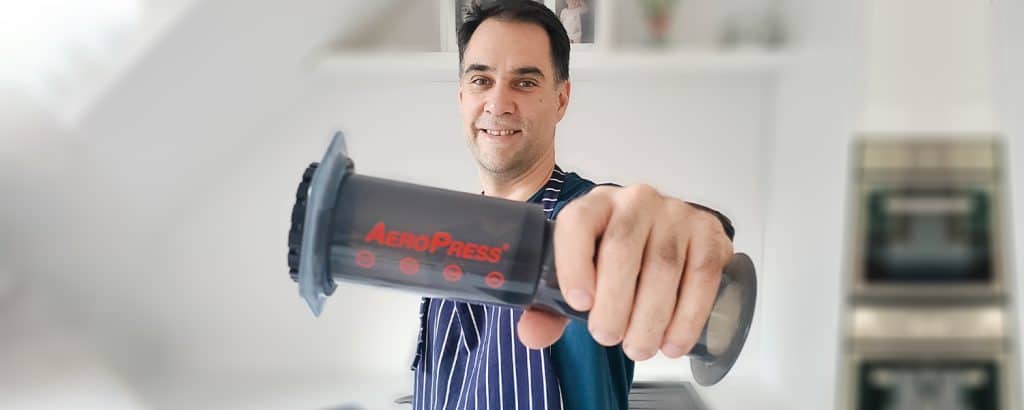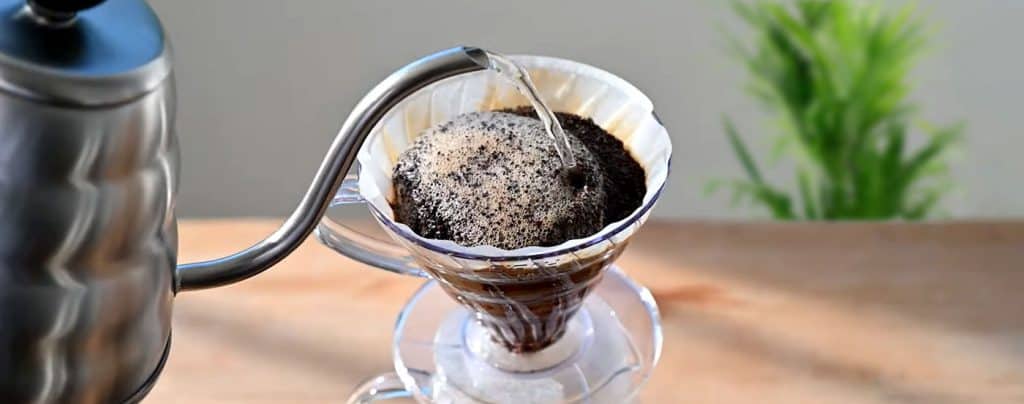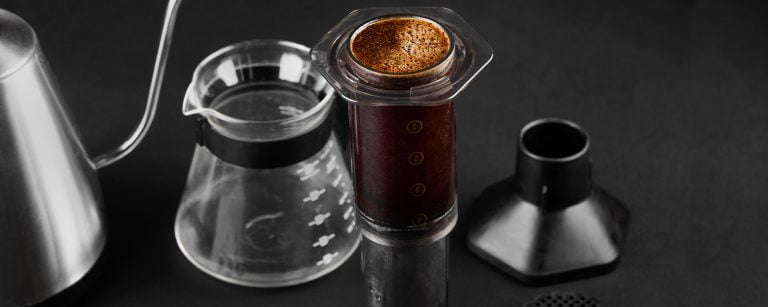AeroPress vs Hario V60 – Barista’s Honest Comparison
One time as I was packing for a hike with my friends, I got stumped picking between two of my favorite portable brewers, the AeroPress and Hario V60. I couldn’t help but ask, which one is better?
These two brewers have become incredibly popular in the specialty coffee world and for good reason. In this article, I’m going to dive deep into comparing these two brewing methods so you can decide which one suits your taste better.
So grab a cup of joe and let’s settle this debate once and for all.
Comparing AeroPress & Hario V60 – Which Method is Better?
So, which is better, the AeroPress or Hario V60? It depends on what you’re looking for in your coffee.


One of the most unique and efficient ways to make coffee is through AeroPress. This innovative device utilizes a piston that pushes hot water through coffee grounds suspended in warm water at high pressure. The result: a smooth cup of joe that’s rich in flavor and low on bitterness.
Hario V60, on the other hand, uses a more traditional pour-over method. It has become increasingly popular amongst specialty coffee shops for its ability to highlight the flavors and nuances of single-origin coffees. Hario V60 features a conical dripper with a 60-degree angle that allows the coffee to extract evenly from the grounds while minimizing over-extraction or under-extraction.
Here are the factors to consider when picking between the two brewing methods:
| Features | AeroPress | Hario V60 |
|---|---|---|
| Taste & Flavor | Rich, full-flavored, low acidity | Clean, bright, emphasizes flavor |
| Strength | Adjustable strength | Adjustable strength |
| Ease of Use | Easy and straightforward | Learning curve, requires technique |
| Brewing Speed | 3-4 minutes | 5-7 minutes |
| Versatility | Customizable brewing process | Customizable pour technique, various sizes |
| Durability & Portability | Durable, lightweight, portable | Durable, ceramic/glass/metal options, portable |
| Sustainability | Paper filters, plastic construction | Compostable paper filters, durable materials |
| Cost | Initial cost affordable, ongoing cost for filters | Affordable initial cost, ongoing cost for filters |
Detailed Comparison Between the AeroPress & Hario V60
Here’s a closer look at the factors that set AeroPress and Hario V60 apart from each other.
Taste, Flavor, & Strength
When it comes to coffee taste and flavor, both the AeroPress and Hario V60 offer unique experiences. The AeroPress is known for producing a rich and full-flavored cup of coffee with low acidity, making it perfect for those who enjoy a smooth and mellow brew.
On the other hand, the Hario V60 emphasizes the unique flavor notes of each coffee bean, resulting in a clean and bright brew that is sure to please any discerning palate.
In terms of strength, both brewing methods can produce various degrees of boldness depending on the recipe or coffee beans used. With an AeroPress, you can experiment with different recipes, even these Aeropress championships recipes, to achieve anything from light and delicate to bold and strong cups.
Similarly, Hario V60 users can alter their grind size and pour techniques to create anything from a light-bodied cup to a richer one with bolder flavors.
Overall, both the AeroPress and Hario V60 offer unique coffee-tasting experiences. If you’re looking for a smooth and mellow brew, opt for the AeroPress. But if you prefer clean and bright notes that emphasize the flavor profile of your chosen coffee bean, then go for the Hario V60.
Ease of Use
In terms of the brewers’ ease of use, the AeroPress wins hands down. It’s a simple and straightforward method that requires minimal effort and creates very little mess.
With just a few steps, you can have a delicious cup of coffee in no time. Note that the brewing factors for AeroPress include medium-fine grind size, 175°F to 205°F water temperature, and filters (paper, metal, or cloth) with an optional pressure release filter cap.

While not difficult per se, the Hario V60 has a bit of a learning curve when it comes to getting the timing and pouring methods right. It’s best used with a gooseneck kettle for proper pouring technique. As for the necessary elements, brewing with the Hario V60 (as described in this article) requires medium-fine ground coffee and 195°F to 205°F water temperature with paper, metal, or cloth filters.
Based on this factor alone, I would definitely opt for the AeroPress if I was a beginner. Its effortless nature combined with its ability to extract rich flavors from all types of coffee beans makes it an excellent choice for brewing without the hassle.

Cleaning both brewers is easy, the V60 is slightly easier. Just dispose of the grinds, and rinse with clean water.
Brewing Speed
When it comes to brewing speed, the AeroPress and Hario V60 differ in several ways. The total brewing time from preparation to brewing and cleaning up ranges from 3 to 4 minutes for the AeroPress and about 5-7 minutes for the Hario V60.
The V60 coffee takes longer to make because the ground coffee has to bloom for 30 seconds before pouring the rest of the hot water and letting it drip for a few minutes.
So if you’re someone who is always rushing to get your caffeine fix, then an AeroPress might be your best bet.
Versatility
Versatility is essential when it comes to coffee brewing since every coffee lover has their own distinct taste and preference. In this regard, the AeroPress and Hario V60 are both commendable in customizing your cup of joe, but I feel the Aeropress wins out here.
The AeroPress offers a high level of control over the entire brewing process. You can adjust various aspects such as water temperature, grind size, and pressure – leading to a fully customizable cup of coffee that suits your personal preferences. You can even make “espresso” with an Aeropress. This degree of customization is the reason why there’s a yearly Aeropress championship showcasing new recipes.
As for the Hario V60, it provides ample control on pouring speed and technique allowing you to modify your brew just how you prefer it. It is more flexible though in terms of capacity, with three sizes available:
- 01 Size (1 to 2 cups of coffee)
- 02 Size (1 to 4 cups of coffee)
- 03 Size (1 to 6 cups of coffee)

On the other hand, the AeroPress has less wiggle room in sizes with the standard AeroPress making 10 oz (290 ml) and the AeroPress Go making eight ounces (230 ml) at a time.
Both are versatile coffee brewing methods that offer their unique advantages. While AeroPress allows for comprehensive control over the brewing aspects, the Hario V60 is more flexible when it comes to choosing different sizes and customizing pour techniques.
Durability and Portability
Both brewers are durable and highly portable. The AeroPress is made out of thick plastic which makes it highly durable. Even its silicone seal, which is the most prone to wear and tear, can last really long with proper care. It’s also incredibly lightweight and compact making it easy to pack in your bag during travels.
On the other hand, while ceramic and glass models of the Hario V60 may not be as sturdy as metal ones, they are still relatively durable. However, if you’re looking for something that can withstand a little more wear and tear, there are also metal, copper, and plastic variants available.

With the V60 dripper’s size, it is also easy to carry. Whenever I travel solo and bring my V60 with me, I just take the dripper and leave the carafe at home. Instead, I drip my coffee straight into my cup. It’s that convenient.
Sustainability
Sustainability in coffee is important because it allows us to enjoy our favorite drink without harming the environment, and it is a strength of both brewers.
- The AeroPress and Hario V60 do not consume electricity in the brewing process and both also utilize compostable paper filters or reusable metal or cloth filters.
- On the flip side, AeroPress has a plastic construction that may not be ideal from a sustainability standpoint since plastic can be challenging to recycle.
- On the other hand, Hario V60’s ceramic and glass models may have breakage concerns leading to purchases of additional units over time.
But with proper care, these durable materials make the V60 long-lasting and sustainable.
Ultimately, it’s up to you which one you choose, but I also encourage you to explore other means for a sustainable cup such as using shade-grown coffee and recycling used coffee grounds. By doing so, you can enjoy your coffee guilt-free while also helping the environment.
Cost
When it comes to cost, both the AeroPress and Hario V60 have their pros and cons. The AeroPress itself is relatively affordable, with prices ranging from $30 to $40 depending on where you buy it. However, the use of paper filters can add up quickly over time at a price of $0.02 each in 2024.
Meanwhile, the Hario V60 has a generally affordable price ranging from $10 to $50. But keep in mind that it has a slightly more expensive paper filter at around $0.08 per filter in 2024.
In short, the AeroPress may seem more expensive initially but it has a more affordable recurring cost while the Hario V60 is less expensive but the ongoing cost of paper filters could make it pricier in the long run.
AeroPress and Hario V60 Weighing the Pros & Cons
Now that we’ve gotten a closer look at the features of each brewing method, here’s a quick overview of the pros and cons of AeroPress and Hario V60 so you can finally decide which one is for you:
| Brewing Method | Pros | Cons |
|---|---|---|
| AeroPress | – Highly portable – Versatile – Produces smooth and consistent coffee – Low acidity – Fast and easy to use and clean | – Limited capacity – The plastic body is not eco-friendly |
| Hario V60 | – Highly portable – Various materials and sizes for different needs – Produces delicious coffee with low acidity | – The pouring technique has a learning curve – Ceramic and glass variants can break – Takes longer to make |
You can also check out the benefits and drawbacks of the AeroPress when compared to other brewing methods such as:
While below are the comparisons between Hario V60 and other brewers:
Conclusion
To wrap things up, the two devices are both great brewing options for coffee enthusiasts. The AeroPress aces in versatility, ease of use, and brewing speed while the Hario V60 is more sustainable, flexible in size and materials, and affordable if you use a reusable filter.
Personally, I’d say the AeroPress is better than the Hario V60 because it allows for great control of the brewing process. The fact that it produces smooth and consistent coffee with low acidity in a matter of minutes also makes it an ideal option for those always on the go like me.
Regardless of personal preference, what matters most is choosing a brewing method that suits your lifestyle and needs best. So go ahead, try them both out to see which one works best for you. And let me know in the comments below.







